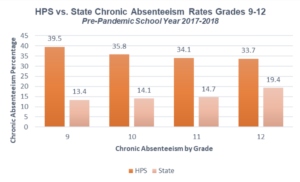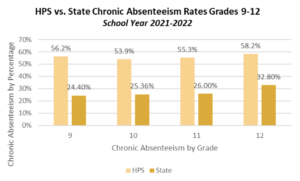Chronic Absenteeism Definition
- Chronic Absenteeism in Connecticut is defined as a student missing a minimum of 18 days per school year. This includes absences that are excused or unexcused, absences due to relocating schools, in-school suspensions that last at least one-half of the school day, and absences due to out-of-school suspensions.
Connecticut’s Chronic Absenteeism Rates
- Connecticut’s chronic absenteeism pre-pandemic rates were low and steady. For the 2019-2020 school year, only about 12% of Connecticut students had high absenteeism rates. The high absenteeism rate in Connecticut nearly doubled to 24% by the 2021-2022 school year.
- In Connecticut, 1 in 10 students was considered to have a high absenteeism rate based on CSDE data gathered from the 2014-2015 school year.
- Connecticuts urban districts make up a significant part of the high absenteeism rates. African American and Latino/Hispanic students’ high absenteeism rates are more than twice that of white students in Connecticut.
Hartford Absenteeism Rates
Hartford Public Schools superintendent, Leslie Torres-Rodriguez, declared absenteeism a crisis in 2018 when absenteeism rates were around 25%. Hartford Public School’s absenteeism rates were nearly double the state’s absenteeism rate for the 2021-2022 school year, making Hartford the highest district with chronic absenteeism in its region ( Chronic absenteeism rose 80% in Connecticut during the pandemic. See how a few districts are getting kids back to school – Hartford Courant).



On Hartford Public Schools website, they highlighted common characteristics of absentees.
-
- Though we are focusing on high school absenteeism, it’s important to follow among all age groups due to its correlation with academic attainment
- Absenteeism is most common among younger students
- Data shows that 1 out of 10 kindergarten and first-grade students miss at least 18 days of school (equivalent to 10% of school year)
- Middle school high absenteeism rates are one of the leading indicators of a student dropping out
- 9th graders’ attendance rate is a greater indicator of whether or not a student will remain in school besides test scores
- Absenteeism is most common among younger students
- HPS absentee characteristics are influenced by factors outside of the classroom (attendance barriers)
- Factors such as health, poor transportation, and unstable housing can impact a student’s ability to come to school
- Though we are focusing on high school absenteeism, it’s important to follow among all age groups due to its correlation with academic attainment
Current HPS protocols for absenteeism:
Hartford Public Schools has used various methods to address chronic absenteeism. HPS identified a variety of root-causes for absenteeism including;
- COVID
- Illness
- Appointment
- Behaviors
- Childcare
- Technology
- Working
- Transportation
- Mental Health
The three root causes with the highest occurrence by the district are:
- Behavior
- Illness
- Mental Health

Based upon these root causes HPS implemented Attendance, Culture, and Engagement (ACE) teams to address these root causes in schools. The ACE teams work by categorizing students based on their risk for chronic absenteeism, then they implement different interventions based on the level of risk. These interventions include:
- home visits
- increased teacher communication
- twilight visits
- implementing consistent no-show protocols
- new attendance data tracking systems and protocols.
In the fall of 2022, HPS focused on rolling out district-wide incentives, training all staff on attendance data collection programs, mentoring programs, consistent disengagement protocols, and many other interventions. Through these interventions, HPS was able to re-engage 30 students in the first week of school as well as various other re-engagement celebrations. They plan to continue these interventions and programs into the upcoming school year.

